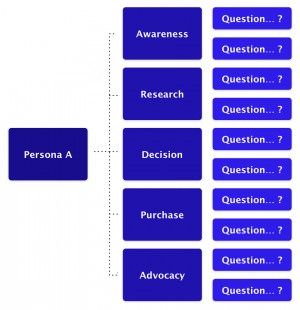A process for content mapping and workflow
I've posted a few weeks ago on marketing automation and also this week on lead nurturing, the concept is reliant on having great content at each and every stage, so I thought a post might offer some further insight. It's also easier than you think, a relatively simple and practical process that can be tested and improved upon over time.
What exactly is content mapping?
Content mapping is (amongst other things) a process for lead nurturing by which a team prepares and organises relevant and valuable content. Once done, this content can be distributed to prospects depending on the type of lead (persona) and their point in the buying cycle (scenario).
Create and map content that generates buyers
- Persona definition - you'll already understand your personas from my last posts - once again Im stressing how effective persona definition is key, otherwise how do you know who you're writing for? "A buyer", "a customer" or "Jill: a UK middle aged consumer seeking…". Get the point? Depending on your company, you may have 3 personas or you may have 50. It all depends on your products/services and all the different types of people who become customers of what you offer

- Define the buyer stages and then the scenarios - so think of the conversion funnel as one way to illustrate that. So you have your leads' personas. Define in what stages of the lead nurturing process you place these personas - you need to know where they are in the buying cycle so you provide them with the relevant content they want and/or need. Below is an example of such tiers that you'll recognise for higher ticket items and B2B products, make sure your stages are relevant to you and remember the personas may not all appear at every stage. The key is to think about the persona questions (see the diagram to the right) at these stages and ensure you really appreciate the unmet needs, the needs your content could fill for real people, not work to a generic notion of 'a customer' and someone else's funnel. Map the questions down - these are indicating the scenarios:
- Awareness: Leads are figuring out if they have a need for your product/service
- Research: Leads want more information on why your product is so valuable
- Decision: Leads are researching alternatives and deciding which one is the best fit for them
- Purchase: Leads (now a customer) need reaffirming that they made a great decision. You may consider on-selling here, after all the hottest prospect is on who just bought
- Advocacy: Here's the chance to up-sell or on-sell over time. There's an even bigger opportunity though to encourage dialogue about their experience, leveraging social networks are great here since it puts 'social proof' of your brand where others can find it - see point #1
- Content types and topics. With our imaginary funnel in mind - consider the types of content that are needed at those stages to answer those types of questions. Here's a good post to help get into the detail of what those personas might want. What do you need to offer exactly. You've got to think about the kind of content and then the best format for the content to live in, answering questions is the simplest means to do this by persona and by scenario
- Awareness: The classic example here, especially in B2B world, is to provide educational papers on the company or ideally the industry - anything that educates and informs the lead. White-papers, ebooks, reports, info-graphics and videos all rule and are (crucially) highly re-shareable from a social marketing perspective (and so SEO perspective).
- Research: Provide context for your products and services, how do you measure up within the options available to the buyer, think about how perfect video is for this - you can communicate a lot in one minute! Consider demonstrating social proof at this stage too (user generated content in the social space) and also the stage before
- Decision: Consider specifics on why the company is so great, think about promotional information such as free-trails, build further credibility through industry awards and recognitions. Webinars and longer videos represent a great format at this stage simply because the buyer is more serious, determined and you've hopefully have earned their attention already. Note - the quality of the content at the earlier stages is key for earning that attention at the latter stages.
- Purchase: It's all about partner and customer testimonials that show how great your product/service has been for years. You could also think about more promotional content for on-selling
- Advocacy: how a company can benefit from even more, such as upgrades or complementary product offerings
- Re-purpose existing content first - then fill in the gaps. Audit your existing content first, what can you re-shape and re-purpose? You might have more for certain persona types and/or buyer stages than others. That's fine, you'll know where the gaps are. With the gaps in mind - fill them! Knowing the gaps helps you prioritise the work, as well as inform content marketing opportunities outside of just the lead nurturing process. Make sure to address your buyer persona’s information needs, those questions, before anything else and also the best content formats at different stages. This process isn’t just about knowing what to send out next, it’s about understanding those needs and then ensuring relevance through being helpful and valuable.







